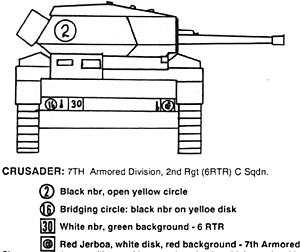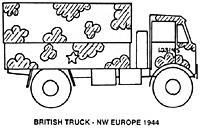
Europe, 1939 - 1940
The British Expeditionary Force (BEF) arrived for war comprehensively marked and camouflaged. Three colors were made standard for camouflage. Equipment was painted overall khaki green. Dark green was almost universally painted by the vehicle crews in irregular bands over the khaki green. Light green was also occasionally used in addition to dark green. Zaloga (#13 in the bibliography) shows a Mk VI light tank in this three tone scheme. British vehicles didn't carry national markings, but carried almost every other kind. Many vehicles carried 12 inch white squares on the hull for recognition, but this wasn't popular. All but two of the regiment-and-above sized armored formations in the BEF carried unique unit insignia.
They also carried tactical markings in the form of colored blocks (red, green, or black) containing code numbers and white bars (on top to denote corps units, on bottom to denote army units). These appeared on hull fronts and rears on the left side and seem to have been about twelve inches square.
Additionally, armored units carried regiment (or battalion) and squadron (or company) signs. These were hollow diamonds, triangles, squares, or circles for the headquarters and first through third squadrons, respectively. They were red, yellow, or blue, for the senior, middle, or junior regiments of a brigade, or were white for unbrigaded regiments.
To make things more interesting, numerous units amended or ignored the color specifications, and one, the 7th Royal Tank Regiment, used solid white shapes. These markings appeared on turret sides and varied in size. Samples and further explanation of these appear in Zaloga (#13 in the bibliography) and Bradford (#I in the bibliography).
British equipment all carried bridging circles, which were yellow discs applied to hull front and rear and containing a black weight number. Vehicles also often had blobs of yellow-green "anti-gas" paint applied to one or more conspicuous places to alert crews to gas attacks. Vehicles normally carried serial numbers in one inch characters. These appeared on the hull or turret sides. Some vehicles still carried civilian license plates - black rectangles with white numbers - front and rear. Finally, vehicles frequently carried names, normally in white letters.
North Africa, 1940 - 1943
According to Bradford (#1 in the bibliography), the British early on suffered an acute shortage of paint. As a result, in the interests of consistency in camouflage, a multicolored diagonally striped pattern was used during this period, incorporating whatever colors were available. Whether this was indeed the reason, or some other was, the pattern wasn't consistently applied, either in pattern, or in color.
Three colors were used, darkest on top, lightest on bottom. As British vehicles in the desert started out in light stone (a sort of grey-tan) overall, this was commonly the bottom color. Combinations for the other colors included black over khaki green, slate grey over silver grey, and khaki green over silver grey, brown (either dark brown drab or terra cotta) over silver grey, and even brown over khaki green! During 1941, as paint stocks improved, these patterns began to be replaced by overall khaki brown (a dark sand color) both with and without brown, black, or khaki green patches and bands as camouflage. Khaki brown became, until 1944, the most common color for British tanks.
Unit insignia, tactical markings, regiment and squadron signs, bridging circles, and vehicle names all continued in use in the desert. Anti- gas paint patches seem to have disappeared sometime during this period. During Operation Crusader, in November 1941, British tanks involved were marked with three vertical strips on hull front and turret sides in white-red-white. These weren't popular (too visible) and were obscured shortly thereafter. In March, 1942, a new recognition flash appeared - a red-white-red flash measuring about ten inches square. This normally appeared on hull fronts and sides of British armor in Tunisia.
Italy, 1943-1945
Colors and markings remained as they'd been at the end of the North African campaign - khaki brown with or without disruptive camouflage. The Allied star started appearing on British vehicles during 1943, normally on top surfaces such as engine decks, to aid in air recognition. Also, the red-white-red flash introduced in 1942 continued in use.
 Northwest Europe, 1944 - 1945
Northwest Europe, 1944 - 1945
British Truck (NW Europe 1944): Hatched areas black, base color khaki drab, and white markings
In 1944, the base color for British equipment changed from khaki brown to khaki drab. This was similar to the early war khaki green but had more of a brown tint to it. As ever, nothing was universal. On D-Day, British armor appeared in khaki drab, khaki brown, and even (for equipment that'd been in the UK throughout the war) a few in the older khaki green.
This was exacerbated by the fact that American and Canadian equipment procured by the British had base coats of olive drab. Also new for D-Day was the "Mickey Mouse" camouflage pattern. This involved overpainting the base coat, whatever it was, with circular blobs of black, joined, and as Wise (#9 in the bibliography) noted, gave an impression somewhat like black cumulus clouds. Using this pattern, the chassis undersides of vehicles were painted entirely black, and the black areas concentrated on the upper surfaces of the vehicle. This pattern wasn't extremely neat; it was applied at depots freehand with paintbrushes. When applied to vehicles with khaki brown base coats, or when applied thinly over khaki drab, the black often looked like a very dark brown. Olive drab-painted equipment normally remained that color until repainting was necessary, when it received a coat of khaki drab. This led to interesting mixes of vehicle paint schemes within single units. During the winter of 1944-45, the British, like the Americans, used whitewash to snow camouflage their AFV's.
British AFV's continued to carry the allied star, bridging circles, and vehicle serials, but the red-white-red flash disappeared. Tactical markings - arm of service patches - were still carried on the left front and rear of the hull, but the colors by now had changed somewhat from those of 1940, though the corps and army white bars remained. Wise (#9 in the bibliography) provides a wealth of detail on specific colors for the various arms of the service.
Units from brigade level and up had identifying formation signs specific to the unit. Everybody's heard of the 7th Armoured Division's red Jerboa on a white field (the Desert Rats). Most other formations had similarly unique signs. Regimental and squadron signs also continued to be used with little change. Where a brigade owned a fourth regiment, the signs for that regiment were green. Where a regiment owned a fourth squadron, that squadron's sign was a vertical rectangle. I've seen numerous photos of British AFV's with turret numbers. I've been unable to determine how widespread their use was, or in what patterns they were applied. Finally, the British, like the Americans, used red and yellow flourescent panels for air recognition, for the same reason.
Painting British armor can be the most complicated thing you do when preparing your miniature armies. The camouflage, and certainly the markings, are not too complex to paint. The time eater is the fact that the British were so concientious in ensuring that all of their equipment carried all of the mandated markings. From long personal experience, in the smaller scales, freehand painting of formation signs, regiment and squadron signs, and arm of service patches, is the only way to go. It takes a while (a long while) but if you're patient, it isn't too difficult. Bridging circles are simply spots of yellow paint with black spots within. In the larger scales, decals abound with which to mark your tanks.
More WWII Armor Colors and Markings Europe and North Africa
- Introduction
France
USA
Soviet Union
United Kingdom and Commonwealth
Germany
Italy
Color, Paint, and Decal Sources
General Painting Comments
Bibliography
Back to Table of Contents -- Courier #57
To Courier List of Issues
To MagWeb Master Magazine List
© Copyright 1992 by The Courier Publishing Company.
This article appears in MagWeb (Magazine Web) on the Internet World Wide Web.
Other military history articles and gaming articles are available at http://www.magweb.com